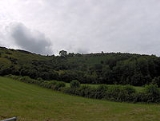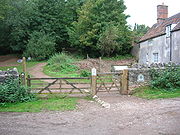
Crook Peak to Shute Shelve Hill
Encyclopedia
Crook Peak to Shute Shelve Hill to is a 332.2 hectare
(820.9 acre) geological and biological Site of Special Scientific Interest near the western end of the Mendip Hills
, Somerset
, notified in 1952.
and the disused Cheddar Valley railway line
. From west to east the site includes these hills:
Most of the site is owned by the National Trust
.
A long-distance footpath, the Mendip Way
, follows much of the northern boundary of the site.
 This site comprises a wide range of habitats which includes ancient and secondary semi-natural broadleaved woodland
This site comprises a wide range of habitats which includes ancient and secondary semi-natural broadleaved woodland
, unimproved calcareous grassland
and a complex mosaic of calcareous grassland and acidic dry dwarf-shrub heath. Four of the calcareous
grassland communities, two of the woodland types and the calcareous grassland/acidic dry dwarf-shrub heath mosaic all have a restricted distribution in Britain. Four nationally rare and seven notable plant species are also present. Plants of interest include the nationally rare Cheddar Pink (Dianthus gratianopolitanus), Bedstraw (Galium fleurotii), Dwarf Sedge (Carex humilis) and Dwarf Mouse-ear (Cerastium pumilum). Rose Wood and King's Wood are ancient woodland sites. The nationally rare Purple Gromwell
(Lithospermum purpurocaeruleum) occurs at Rose Wood.
. The rich Layer 3 fauna, radiocarbon dated
to 34,265 (+2600/–1950) years BP, includes Spotted Hyena
, Lion
, Arctic fox
, Mammoth
, Woolly Rhinoceros
, horse
, reindeer
, suslik
and Tundra Vole
. The site is a major source of information for this phase of the Middle Devensian. It is also the most carefully excavated hyena-den site and assemblage from Britain.
Shute Shelve Cavern
is located on Shute Shelve Hill.
Hectare
The hectare is a metric unit of area defined as 10,000 square metres , and primarily used in the measurement of land. In 1795, when the metric system was introduced, the are was defined as being 100 square metres and the hectare was thus 100 ares or 1/100 km2...
(820.9 acre) geological and biological Site of Special Scientific Interest near the western end of the Mendip Hills
Mendip Hills
The Mendip Hills is a range of limestone hills to the south of Bristol and Bath in Somerset, England. Running east to west between Weston-super-Mare and Frome, the hills overlook the Somerset Levels to the south and the Avon Valley to the north...
, Somerset
Somerset
The ceremonial and non-metropolitan county of Somerset in South West England borders Bristol and Gloucestershire to the north, Wiltshire to the east, Dorset to the south-east, and Devon to the south-west. It is partly bounded to the north and west by the Bristol Channel and the estuary of the...
, notified in 1952.
The site
The site extends for some 5 km from west to east. Near its eastern end it is divided by a gap used by the A38 roadA38 road
The A38, part of which is also known as the Devon Expressway, is a major A-class trunk road in England.The road runs from Bodmin in Cornwall to Mansfield in Nottinghamshire. It is long, making it one of the longest A-roads in England. It was formerly known as the Leeds — Exeter Trunk Road,...
and the disused Cheddar Valley railway line
Cheddar Valley line
The Cheddar Valley line was a railway line in Somerset, England, opened in 1869 and closed in 1963. It became known as The Strawberry Line because of the volume of locally-grown strawberries that it carried....
. From west to east the site includes these hills:
- Crook Peak, reaching 191 metres (626.6 ft), a prominent feature from the surrounding landscape. Evidence of early human occupation includes a polished flintFlintFlint is a hard, sedimentary cryptocrystalline form of the mineral quartz, categorized as a variety of chert. It occurs chiefly as nodules and masses in sedimentary rocks, such as chalks and limestones. Inside the nodule, flint is usually dark grey, black, green, white, or brown in colour, and...
axeAxeThe axe, or ax, is an implement that has been used for millennia to shape, split and cut wood; to harvest timber; as a weapon; and as a ceremonial or heraldic symbol...
. A ridge to the south east of Crook Peak, known as 'The Razor', is used by the West Mendip Soaring Association to fly model aircraftModel aircraftModel aircraft are flying or non-flying models of existing or imaginary aircraft using a variety of materials including plastic, diecast metal, polystyrene, balsa wood, foam and fibreglass...
in south-westerly / southerly or north-easterly winds. - Compton Hill, above the village of Compton BishopCompton BishopCompton Bishop is a small village and civil parish, at the western end of the Mendip Hills in the English county of Somerset. It is located close to the historic town of Axbridge...
- Wavering Down, reaching a height of 211 metres (692.3 ft)
- Cross Plain, above the village of Cross
- Shute Shelve Hill, east of the A38 road, reaching a height of 233 metres (764.4 ft), above the town of AxbridgeAxbridgeAxbridge is a town in Somerset, England, situated in the Sedgemoor district on the River Axe, near the southern edge of the Mendip Hills. The town population according to the 2001 census was 2,024.-History:...
and adjoining Axbridge Hill and Fry's HillAxbridge Hill and Fry's HillAxbridge Hill and Fry's Hill is a biological Site of Special Scientific Interest in the Mendip Hills, Somerset, notified in 1990. The hills are above the town of Axbridge, immediately to the east of Shute Shelve Hill....
Most of the site is owned by the National Trust
National Trust for Places of Historic Interest or Natural Beauty
The National Trust for Places of Historic Interest or Natural Beauty, usually known as the National Trust, is a conservation organisation in England, Wales and Northern Ireland...
.
A long-distance footpath, the Mendip Way
Mendip Way
The Mendip Way is an long-distance footpath across the Mendip Hills from Weston-super-Mare to Frome. It is divided into two sections.The West Mendip Way was opened in 1979 and starts at the Bristol Channel at Uphill Cliff. It climbs the Mendip escarpment affording views over the Somerset Levels....
, follows much of the northern boundary of the site.
Etymology
Crook Peak has been important as a landmark and boundary from very early times, and the origins of the name are unclear. Some believe the name 'Crook' comes from Old British 'Cruc' meaning 'peak' or 'pointed hill'.Biological

Ancient woodland
Ancient woodland is a term used in the United Kingdom to refer specifically to woodland that has existed continuously since 1600 or before in England and Wales . Before those dates, planting of new woodland was uncommon, so a wood present in 1600 was likely to have developed naturally...
, unimproved calcareous grassland
Calcareous grassland
Calcareous grassland is an ecosystem associated with thin basic soil, such as that on chalk and limestone downland. Plants on calcareous grassland are typically short and hardy, and include grasses and herbs such as clover...
and a complex mosaic of calcareous grassland and acidic dry dwarf-shrub heath. Four of the calcareous
grassland communities, two of the woodland types and the calcareous grassland/acidic dry dwarf-shrub heath mosaic all have a restricted distribution in Britain. Four nationally rare and seven notable plant species are also present. Plants of interest include the nationally rare Cheddar Pink (Dianthus gratianopolitanus), Bedstraw (Galium fleurotii), Dwarf Sedge (Carex humilis) and Dwarf Mouse-ear (Cerastium pumilum). Rose Wood and King's Wood are ancient woodland sites. The nationally rare Purple Gromwell
Lithospermum purpurocaeruleum
Lithospermum purpurocaerula or Purple Gromwell is a herbaceous perennial rhizomatous plant of the genus Lithospermum, belonging to the family Boraginaceae.-Etymology:...
(Lithospermum purpurocaeruleum) occurs at Rose Wood.
Geological
There are cave deposits of interest at the southern end of Crook Peak. Picken's Hole is of considerable importance because of its clear, well-stratified sequence of deposits and faunas, all dating from within the DevensianWisconsin glaciation
The last glacial period was the most recent glacial period within the current ice age occurring during the last years of the Pleistocene, from approximately 110,000 to 10,000 years ago....
. The rich Layer 3 fauna, radiocarbon dated
Radiocarbon dating
Radiocarbon dating is a radiometric dating method that uses the naturally occurring radioisotope carbon-14 to estimate the age of carbon-bearing materials up to about 58,000 to 62,000 years. Raw, i.e. uncalibrated, radiocarbon ages are usually reported in radiocarbon years "Before Present" ,...
to 34,265 (+2600/–1950) years BP, includes Spotted Hyena
Spotted Hyena
The spotted hyena also known as laughing hyena, is a carnivorous mammal of the family Hyaenidae, of which it is the largest extant member. Though the species' prehistoric range included Eurasia extending from Atlantic Europe to China, it now only occurs in all of Africa south of the Sahara save...
, Lion
Lion
The lion is one of the four big cats in the genus Panthera, and a member of the family Felidae. With some males exceeding 250 kg in weight, it is the second-largest living cat after the tiger...
, Arctic fox
Arctic fox
The arctic fox , also known as the white fox, polar fox or snow fox, is a small fox native to Arctic regions of the Northern Hemisphere and is common throughout the Arctic tundra biome. The Greek word alopex, means a fox and Vulpes is the Latin version...
, Mammoth
Mammoth
A mammoth is any species of the extinct genus Mammuthus. These proboscideans are members of Elephantidae, the family of elephants and mammoths, and close relatives of modern elephants. They were often equipped with long curved tusks and, in northern species, a covering of long hair...
, Woolly Rhinoceros
Woolly Rhinoceros
The woolly rhinoceros is an extinct species of rhinoceros that was common throughout Europe and Asia during the Pleistocene epoch and survived the last glacial period. The genus name Coelodonta means "cavity tooth"...
, horse
Horse
The horse is one of two extant subspecies of Equus ferus, or the wild horse. It is a single-hooved mammal belonging to the taxonomic family Equidae. The horse has evolved over the past 45 to 55 million years from a small multi-toed creature into the large, single-toed animal of today...
, reindeer
Reindeer
The reindeer , also known as the caribou in North America, is a deer from the Arctic and Subarctic, including both resident and migratory populations. While overall widespread and numerous, some of its subspecies are rare and one has already gone extinct.Reindeer vary considerably in color and size...
, suslik
European ground squirrel
The European ground squirrel , also known as the European souslik, is a species from the squirrel family Sciuridae and is besides the speckled ground squirrel the only European representative of the genus Spermophilus...
and Tundra Vole
Tundra Vole
The Tundra Vole or Root Vole, Microtus oeconomus, is a medium-sized vole found in Northern and Central Europe, Asia, and northwestern North America, including Alaska and northwestern Canada...
. The site is a major source of information for this phase of the Middle Devensian. It is also the most carefully excavated hyena-den site and assemblage from Britain.
Shute Shelve Cavern
Shute Shelve Cavern
Shute Shelve Cavern is a natural cave system located in Shute Shelve Hill, Somerset, England above Axbridge in the Mendip Hills not far from Cheddar....
is located on Shute Shelve Hill.

